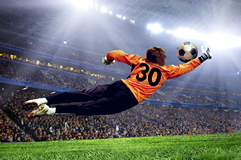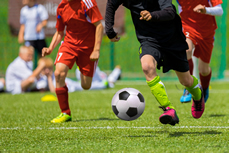
As soccer is a sport of almost constant motion, for the players and the ball, well developed dynamic acuity is just as significant as good static acuity.
The following is an explanation of the most relevant dynamic visual skills associated with basketball. These are all learned skills that can be improved with practice.

Opportunities to make a proper pass, nutmeg a player (kick the ball between his legs), or tackle an opponent and steal the ball without fouling, only present themselves for fractions of seconds. Also, the soccer ball itself can move at high rates of speed. Once the ball starts ricocheting off players who are fighting for its control, reaction speed can be the difference between a winner and a loser. The player must be able to absorb a great deal of information, with just a quick scan of the field in order to make his decision for play development – i.e. – whether or not to pass the ball, and where and how to make his next move.
Most soccer players depend more on eye-foot and eye-body coordination, than on eye-hand; except the goaltenders, who are permitted to use their hands to catch, throw and block shots taken on their goal. The eyes lead the body, so the visual system guides the motor system. For the players, exact eye-foot coordination is essential to hit a solid volley or half-volley and to ensure that the ball goes in the right direction and is perfectly on target.
Eye tracking ability is important in soccer. Quick, accurate saccades (or eye movements) are needed to rapidly survey the changing locations and movements of the other 21 players, and the ball on the pitch. The player must also use saccades to monitor the location of the various boundary lines and goals. Studies have shown that if the athlete’s head has to move to aid in eye tracking, his performance is not only less efficient, but balance is thrown off too.
Focusing flexibility is also important because the ball and other players move so quickly. The player has to be able to shift focus from near to far, or to intermediate targets rapidly throughout the game, while general body stamina is running down due to heavy exertion.
Timing, for receiving passes and jumping up to head the ball at just the right moment, are skills related to good depth perception. The player must be able to judge the speed and spin on the ball, as well as how quickly other players are moving toward or away from him.
Also, knowing where you are, relative to other objects, is very important in soccer because traffic patterns on the field can become very congested. No one stays in the same place very long. The ball and the players are all in constant, relative motion. The goals are stationary, but most shots are taken at the goal as the player is moving laterally, vertically, transversely or “all of the above”.
When dribbling the ball, the player must be aware of where he’s going; where the defensive tacklers are coming from; and also be peripherally aware of the soccer ball his foot is controlling. Peripheral awareness also allows the players to use a “heads up” playing style and still be confident in his ball handling/dribbling.
Defensively, he/she must stay between the opponent and the goal. Therefore, he must be centrally aware of the offensive player with the ball, if it’s his responsibility to mark (guard) him. Peripherally, he must be aware of the goal and potential passing lanes the offense might use. Also, if he is marking a player away from the ball, he must be peripherally aware of the ball and the goal.
This is not only a very essential skill for superior performance in a game like soccer, but it also helps avoid collision and injury. Each player must be aware of (1) the location of the ball, (2) where he should be in relation to the action going on at any given time, (3) where his opponents and his teammates are if he is in control of the ball and (4) where he is on the pitch (playing field) in relationship to the numerous boundaries.
Other dynamic visual skills required in soccer are Concentration, Eye Fatigue, and Fixation Ability